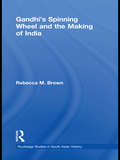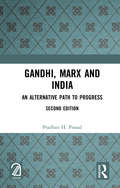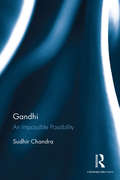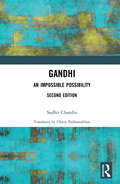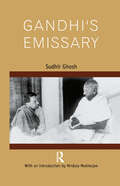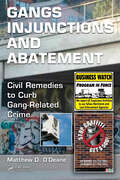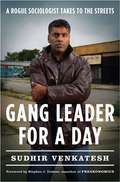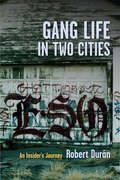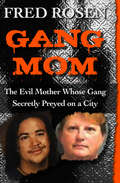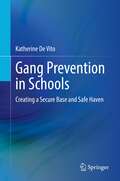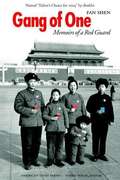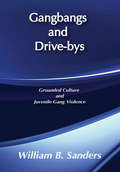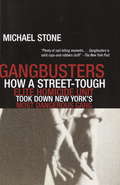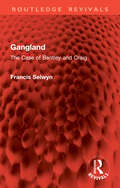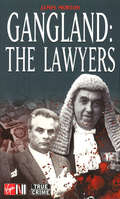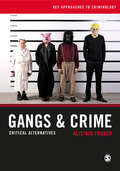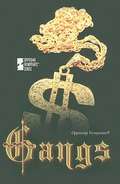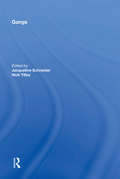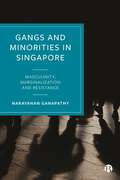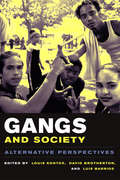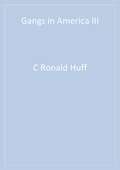- Table View
- List View
Gandhi's Spinning Wheel and the Making of India (Routledge Studies in South Asian History)
by Rebecca BrownGandhi’s use of the spinning wheel was one of the most significant unifying elements of the nationalist movement in India. Spinning was seen as an economic and political activity that could bring together the diverse population of South Asia, and allow the formerly elite nationalist movement to connect to the broader Indian population. This book looks at the politics of spinning both as a visual symbol and as a symbolic practice. It traces the genealogy of spinning from its early colonial manifestations in Company painting to its appropriation by the anti-colonial movement. This complex of visual imagery and performative ritual had the potential to overcome labour, gender, and religious divisions and thereby produce an accessible and effective symbol for the Gandhian anti-colonial movement. By thoroughly examining all aspects of this symbol’s deployment, this book unpacks the politics of the spinning wheel and provides a model for the analysis of political symbols elsewhere. It also probes the successes of India’s particular anti-colonial movement, making an invaluable contribution to studies in social and cultural history, as well as South Asian Studies.
Gandhi, Marx and India: An Alternative Path to Progress
by Pradhan H. PrasadThe book unravels the dynamics of capitalist development, critically assesses the socialist experiment in charting out a course of development different from capitalism, explains the contradictions in the post-Independence development process in India, evaluates other efforts outside the state towards ushering in 'development', and then proposes an alternative path to progress - an employment based ecologically sustainable model of decentralized development based on local resource endowment and heightened mass consciousness which will take the country out of the dependency paradigm.Please note: Taylor & Francis does not sell or distribute the Hardback in India, Pakistan, Nepal, Bhutan, Bangladesh and Sri Lanka.
Gandhi: An Impossible Possibility
by Sudhir ChandraFor a man who made such a powerful intervention in the history of the 20th century, many of Mahatma Gandhi’s ideas were misunderstood or obfuscated during his lifetime. This book draws our attention to Gandhi’s last years, particularly the marked change in his understanding of the acceptance of non-violence by Indians. It points to a startling discovery Gandhi made in the years preceding India’s Independence and Partition: the struggle for freedom which he had all along believed to be non-violent was in fact not so. He realised that there was a causal relationship between the path of illusory ahimsa which had held sway during the freedom struggle and the violence that erupted thereafter during Partition. Calling for a serious rethink on the very nature and foundation of modern India, this book throws new light on Gandhian philosophy and its far-reaching implications for the world today. It will interest not only scholars and researchers of modern Indian history, politics, and philosophy but also lay readers.
Gandhi: An Impossible Possibility
by Sudhir ChandraGandhi was perhaps the most influential yet misunderstood figure of the twentieth century. Drawing close attention to his last years, this book explores the marked change in his understanding of the acceptance of non-violence by Indians. It points to a startling discovery Gandhi made in the years preceding India’s Independence and Partition: the struggle for freedom which he had all along believed to be non-violent was in fact not so. He realised that there was a causal relationship between the path of illusory ahimsa, which had held sway during the freedom struggle, and the violence that erupted thereafter during Partition. In the second edition of this much-acclaimed volume, Chandra revisits Gandhi’s philosophy to explain how and why the phenomenon of the Mahatma has been understood and misunderstood through the years. Calling for a rethink of the very nature and foundation of modern India, this book throws new light on Gandhian philosophy and its far-reaching implications for the world today. It will interest not only scholars and researchers of modern Indian history, politics and philosophy, but also lay readers.
Gandhi’s Emissary
by Sudhir GhoshIn 1946, at the age of 29, the author was chosen by Mahatma Gandhi to act as unofficial emissary between the British Labour Government and India in the delicate negotiations which resulted in the country’s independence. His unique position enabled him to give the world a moving and informed account of the principal actors in the drama that led to the division of India and Pakistan and the creation of a parliamentary democracy in India. With the resurgence of interest and debate on Partition in India and Pakistan, and around the world, in the context of current international groupings, it is fitting that this book be brought back into circulation.
Gang Busters: The Crime Fighters of American Broadcasting
by Martin GramsFrom 1935 to 1958, GANG BUSTERS established a reputation for presenting authentic case histories from the files of law enforcement, re-enactments of the criminal underworld including "Baby-Face" Nelson, Ma Barker and her boys, John Dillinger, and Willie "The Actor" Sutton. Thrilling escapades such as the Alcatraz Prison Riot and million dollar bank robberies were the subject of GANG BUSTERS broadcasts. Colonel H. Norman Schwarzkopf (father of the same Gulf-War Schwarzkopf) and New York's Lewis J. Valentine were two of the many weekly hosts who introduced each broadcast. GANG BUSTERS was the first radio program to feature weekly "clues" describing convicts at large, assailants wanted by the Federal Bureau of Investigation, and listeners paid close attention to the details, which gave local law enforcement an edge in the apprehension of more than 300 criminals during the program's 20-year run. GANG BUSTERS also expanded into a television series, two big- screen movies, a matinee serial and a lengthy series of comic books. This book features a documentary about the GANG BUSTERS program, covering every aspect of the series including background production, lawsuits from listeners, a biography about Phillips H. Lord, the creator of the series, and a complete episode guide for each and every radio and television broadcast.
Gang Injunctions and Abatement: Using Civil Remedies to Curb Gang-Related Crimes
by Matthew D. O'DeaneAs gang violence continues to rise across the country and the world, police departments, prosecutors, and community members are seeking new methods to reduce the spread of gang-related criminal activity. Civil gang injunctions have become a growing feature of crime control programs in several states across the nation. Gang Injunctions and Abatement
Gang Leader for a Day: A Rogue Sociologist Takes to the Streets
by Sudhir Alladi VenkateshGang Leader for a Day is the fascinating full story of how Sudhir Venkatesh managed to gain entrance into the gang, what he learned, and how his method revolutionized the academic establishment. When Venkatesh walked into an abandoned building in one of Chicago's most notorious housing projects, he was looking for people to take a multiple-choice survey on urban poverty. A first-year grad student hoping to impress his professors with his boldness, he never imagined that as a result of the assignment he would befriend a gang leader named JT and spend the better part of a decade inside the projects under JT's protection, documenting what he saw there. Over the next seven years, Venkatesh got to know the neighborhood dealers, crackheads, squatters, prostitutes, pimps, activists, cops, organizers, and officials. From his privileged position of unprecedented access, he observed JT and the rest of the gang as they operated their crack-selling business, conducted PR within their community, and rose up or fell within the ranks of the gang's complex organizational structure. In Hollywood-speak, Gang Leader for a Day is The Wire meets Harvard University. It's a brazen, page turning, and fundamentally honest view into the morally ambiguous, highly intricate, often corrupt struggle to survive in what is tantamount to an urban war zone. It is also the story of a complicated friendship between Sudhir and JT-two young and ambitious men a universe apart.
Gang Life in Two Cities
by Robert J DuranRefusing to cast gangs in solely criminal terms, Robert J. Durán, a former gang member turned scholar, recasts such groups as an adaptation to the racial oppression of colonization in the American Southwest. Developing a paradigm rooted in ethnographic research and almost two decades of direct experience with gangs, Durán completes the first-ever study to follow so many marginalized groups so intensely for so long, revealing their core characteristics, behavior, and activities within two unlikely American cities.Durán spent five years in Denver, Colorado, and Ogden, Utah, conducting 145 interviews with gang members, law enforcement officers, prosecutors, and other related individuals. From his research, he constructs a comparative outline of the emergence and criminalization of Latino youth groups, the ideals and worlds they create, and the reasons for their persistence. He also underscores the failures of violent gang suppression tactics, which have only further entrenched these groups within the barrio. Encouraging cultural activists and current and former gang members to pursue grassroots empowerment, Durán proposes new solutions to racial oppression that challenge and truly alter the conditions of gang life.
Gang Life in Two Cities: An Insider's Journey
by Robert J. DuránRefusing to cast gangs in solely criminal terms, Robert J. Durán, a former gang member turned scholar, recasts such groups as an adaptation to the racial oppression of colonization in the American Southwest. Developing a paradigm rooted in ethnographic research and almost two decades of direct experience with gangs, Durán completes the first-ever study to follow so many marginalized groups so intensely for so long, revealing their core characteristics, behavior, and activities within two unlikely American cities.Durán spent five years in Denver, Colorado, and Ogden, Utah, conducting 145 interviews with gang members, law enforcement officers, prosecutors, and other relevant individuals. From his research, he constructs a comparative outline of the emergence and criminalization of Latino youth groups, the ideals and worlds they create, and the reasons for their persistence. He also underscores the failures of violent gang suppression tactics, which have only further entrenched these groups within the barrio. Encouraging cultural activists and current and former gang members to pursue grassroots empowerment, Durán proposes new solutions to racial oppression that challenge and truly alter the conditions of gang life.
Gang Mom: The Evil Mother Whose Gang Secretly Preyed on a City
by Fred RosenAaron Iturra was just eighteen years old when he was found dead in his bedroom in Eugene, Oregon. Soon, the quiet community would be rocked and shocked by who was behind the killing: Mary Louise Thompson also known as Gang Mom. An anti-gang activist, she was a modern day deadly Fagin, running her own gang of juveniles who preyed on the unsuspecting city.
Gang Prevention in Schools: Creating a Secure Base and Safe Haven
by Katherine De VitoThis book delves deep into the hidden population of former gang members who share their positive and negative experiences of being gang members. Their stories of violence, hopelessness, despair, and loneliness also offer a seed of hope – they contain the building blocks for prevention. By understanding why they each turned to gangs, how they turned to gangs, and what went wrong for some along their pathways during childhood, as well as how and why they chose to leave the gang lifestyle, we can begin to put the pieces together and understand tools for gang prevention. Schools are in the unique position to become an oasis or a safe haven for a child in a world that does not otherwise feel safe to them. School staff members can step in and become consistent people in a child’s life. They can help to identify at-risk youth and intervene, facilitating a change in path away from gang membership. This book discusses how schools and staff can be instrumental in gang prevention and outlines warning signs and risk and protective factors for gang involvement. It also talks about components of gang prevention programs in schools. Additional topics explored include: Theories of Gang InvolvementLack of Family Consistency: Relating Attachment Theory with Gang Involvement“Brotherhood, Sisterhood, Unity:" Gangs as Replacement Family"No Other Option:" The Role of Social Environment "Death, Jail, or a Turnaround:" Making the Decision to DisengageA Piece About Trauma-Informed PracticeAuthored by a school social worker who has an insider's perspective on working in a school, Gang Prevention in Schools is a useful resource that gives a humanistic view of former gang members. The book will engage readers in the fields of psychology, social work, education and educational administration, and criminal justice, as well as have potential appeal to a lay audience due to the richness of the stories and interviews.
Gang of One: Memoirs of a Red Guard
by Fan ShenIn 1966 twelve-year-old Fan Shen, a newly minted Red Guard, plunged happily into China's Cultural Revolution. Disillusion soon followed, then turned to disgust and fear when Shen discovered that his compatriots had tortured and murdered a doctor whose house he'd helped raid and whose beautiful daughter he secretly adored. A story of coming of age in the midst of monumental historical upheaval, Shen's Gang of One is more than a memoir of one young man's harrowing experience during a time of terror. It is also, in spite of circumstances of remarkable grimness and injustice, an unlikely picaresque tale of adventure full of courage, cunning, wit, tenacity, resourcefulness, and sheer luck--the story of how Shen managed to scheme his way through a hugely oppressive system and emerge triumphant. Gang of One recounts how Shen escaped, again and again, from his appointed fate, as when he somehow found himself a doctor at sixteen and even, miraculously, saved a few lives. In such volatile times, however, good luck could quickly turn to misfortune: a transfer to the East Wind Aircraft Factory got him out of the countryside and into another terrible trap, where many people were driven to suicide; his secret self-education took him from the factory to college, where friendship with an American teacher earned him the wrath of the secret police. Following a path strewn with perils and pitfalls, twists and surprises worthy of Dickens, Shen's story is ultimately an exuberant human comedy unlike any other.
Gangbangs and Drive-Bys: Grounded Culture and Juvenile Gang Violence (Social Problems And Social Issues Ser.)
by William SandersThis study, based on quantitative and qualitative data gathered over a twelve-year period, takes its title from the two predominant styles of gang violence: 'drive-bys,' which have replaced 'rumbles' as the primary form of gang violence; and 'gang-bangs' - a generic term for other gang violence that includes assaults, knifings, and beatings.The author attempts to understand the situations in which a young man would drive up to another human being and, without further ado, blow his head off. By examining hundreds of such situations, and employing both structural and phenomenological analysis, Sanders explores the various configurations of gang violence.Gangbangs and Drive-bys also examines the routines of gang members and their view of life, the different styles of gangs, and changes undergone by gangs from the early 1980s to the end of the same decade. Over that period, the emphasis shifted from parties and paybacks to big money from the sale of rock cocaine, and from unstructured to organized crime. Along with that shift came an increase in the violence.Finally, Sanders traces the beginning and evolution of a metropolitan police gang unit over the same decade in order to present an inside view of how the police attempt to deal with and understand gangs.
Gangbusters: How a Street Tough, Elite Homicide Unit Took Down New York's Most Dangerous Gang
by Michael StoneIn the bestselling tradition of Nicholas Pileggi, Joseph Wambaugh, and Robert Daley's Prince of the City, a thoroughly enthralling story of how the seasoned veterans of New York's elite Homicide Investigation Unit took down the city's most dangerous drug gang, and in the process rewrote the book on tackling gang crime. Gangbusters is a riveting narrative about the secretive, elite Homicide Investigation Unit and its successful investigation and prosecution of the notorious upper Manhattan Wild Cowboys, one of the bloodiest and most violent drug gangs in New York's long history. For two years, veteran reporter Michael Stone was granted exclusive access to the inner workings of HIU, its brilliant and iconoclastic chief, Walter Arsenault, and the seasoned, street-smart detectives and prosecutors who helped to put the Wild Cowboys behind bars. The book opens with the shocking and senseless execution of a Tarrytown college boy on the West Side Highway. Over time, the case leads detectives to the Wild Cowboys, a drug gang whose size and penchant for violence and intimidation have terrorized the South Bronx and upper Manhattan for years. HIU's attempts to bring down the Wild Cowboys' ruthless leader, Lenny, and feared enforcers, Platano and Pasqualito, triggermen for scores of the gang's murders, posed challenges that would test the unit's very survival. But HIU's dedicated collaboration of prosecutors and detectives and the strategies Arsenault employed in the unit's investigation have since become a model for gang enforcement in cities around the world. In the end, the Wild Cowboys and their allies were responsible for more than sixty murders. A rich roller-coaster ride of a narrative with a colorful and, at times, heroic cast of characters, Gangbusters is true crime at its page-turning best.
Gangland: The Case of Bentley and Craig (Routledge Revivals)
by Francis SelwynOn the evening of 2nd November 1952, a shot fired from a makeshift weapon on a warehouse roof in Croydon killed PC Sidney Miles. Next morning the newspaper headlines proclaimed a Chicago gun-battle in London, gangsters machine-gunning armed police over the rooftops.But the trial of Bentley and Craig affronted common sense and alienated a generation raised in the post-war suburbia of cinemas, coffee bars and drab streets. How could Derek Bentley, nineteen and with learning difficulties, be hanged for a murder committed a quarter of an hour after he was arrested? Lord Chief Justice Goddard and the Home Secretary, Sir David Maxwell Fyfe, found a way. The nation was split into those determined to teach young thugs a lesson and those dismayed by an act of judicial murder. The execution of Bentley, wrote Kenneth Allsop in Picture Post, caused an emotional upset in England comparable only to Dunkirk and the death of George VI.Originally published in 1988, Gangland evokes the high drama of those weeks in the autumn of 1952. The moral authoritarianism of the Churchill government was backed by Lord Goddard’s zeal for hanging and flogging, by women’s groups demanding tougher sentences and corporal punishment, by a popular press which portrayed society under threat from cosh-boys and teenage gunmen, flick knives and horror comics, violence on the cinema screen and the printed page.Against this the demonstrators packed Whitehall, chanting ‘Bentley must not die!’ Others pointed out that violent crime was falling rather than rising. Bentley went to his death and thereby perhaps did more to discredit capital punishment than anyone. The facts of the case, including hysteria over sex and violence in the media and the clamour over rising crime which helped to ensure his execution, have a relevance to all periods of history – not least our own.
Gangland: The Lawyers
by James MortonWhile many lawyers are honest, for Gangland figures, the best lawyer is often corrupt – a ‘shyster’ – who will act as a go between with the police, provide false alibis, bribe and intimidate witnesses, jurors and judges and occasionally organise robberies and burglaries. Sometimes these lawyers even kill or may be killed themselves.Gangland: The Lawyers brings us such lawyers as Frank Ragan, who acted for three mob leaders, and James Sawyer, the barrister and forger involved in the first Great train Robbery. From the amazing story of Gambino crime boss John Gotti (the ‘Teflon Don’) and his attorney Bruce Cutler, to the American judge Joseph Peel, who had his co-judge killed, James Morton presents a worldwide history of these shady individuals and their seedy but compelling stories.
Gangs & Crime: Critical Alternatives (Key Approaches to Criminology)
by Alistair FraserThis book takes students on a guided tour of the gang phenomenon through history, as well as current representations of gangs in literature and media. It includes: - A detailed global overview of gang culture, covering, amongst others, Glasgow, Chicago, Hong Kong, and Shanghai - A chapter on researching gangs which covers quantitative and qualitative methods - Extra chapter features such as key terms, chapter overviews, study questions and further reading suggestions. Alistair Fraser brings together gang-literature and critical perspectives in a refreshingly new way, exploring ‘gangs’ as a social group with a long and fascinating history.
Gangs & Crime: Critical Alternatives (Key Approaches to Criminology)
by Alistair FraserThis book takes students on a guided tour of the gang phenomenon through history, as well as current representations of gangs in literature and media. It includes: - A detailed global overview of gang culture, covering, amongst others, Glasgow, Chicago, Hong Kong, and Shanghai - A chapter on researching gangs which covers quantitative and qualitative methods - Extra chapter features such as key terms, chapter overviews, study questions and further reading suggestions. Alistair Fraser brings together gang-literature and critical perspectives in a refreshingly new way, exploring ‘gangs’ as a social group with a long and fascinating history.
Gangs (Opposing Viewpoints Series)
by Adela SolizA compendium of viewpoints--both pro and con--on several issues relating to the prevalence of gangs in American society.
Gangs (The\international Library Of Criminology, Criminal Justice And Penology Ser.)
by Jacqueline SchneiderThe task of researching gangs is fraught with difficulties, central to which are issues of definition and reliance on certain forms of data for analyses. These methodological issues have been acknowledged as limitations in most of the existing research, but they have not been explored as being potentially serious flaws contributing to the proliferation of myth, or as aggravating factors that exacerbate what is essentially a relatively uncomplicated social process. Also unclear from existing studies is the extent to which suppositions about gangs feed moral panics or contribute to the misidentification or over-specification of a problem. This captivating volume focuses on gangs, their formation, identity and behaviour with a view to developing a preventive strategy.
Gangs and Minorities in Singapore: Masculinity, Marginalization and Resistance
by Narayanan GanapathyThis book is a unique ethnographic study of a racially exclusive Malay Muslim gang, Omega, which has its roots in Singapore’s prisons and controls much of the illicit drug trade in the state. Similar to indigenous peoples elsewhere, Singapore Malays are disproportionately represented in the criminal justice system and can respond to structural marginalization and colonization through gang involvement. In demonstrating that gang membership can be an adaptive strategy for minority groups, this book promotes a more inclusive and restorative justice model for people with repeat convictions.
Gangs and Society: Alternative Perspectives
by David C. Brotherton Luis Barrios Louis KontosThis volume addresses timely questions from an eclectic range of positions and brings together the work of academics, activists, and community leaders to examine the many functions and faces of gangs today. Analyzing the spread of gangs from New York to Texas to the West Coast, the book covers such topics as the spirituality of gangs, the place of women in gang culture, and the effect on gangs of a variety of educational programs and services for at-risk youth.
Gangs and Society: Alternative Perspectives
by David C. Brotherton Luis Barrios Eds. Kontos LouisCompiled by three leading experts in the psychological, sociological, and criminal justice fields, this volume addresses timely questions from an eclectic range of positions. The product of a landmark conference on gangs, Gangs and Society brings together the work of academics, activists, and community leaders to examine the many functions and faces of gangs today. Analyzing the spread of gangs from New York to Texas to the West Coast, the book covers such topics as the spirituality of gangs, the place of women in gang culture, and the effect on gangs of a variety of educational programs and services for at-risk youth. The final chapter examines the "gang-photography phenomenon" by looking at the functions and politics of different approaches to gang photography and features a photographic essay by Donna DeCesare, an award-winning journalist.
Gangs in America III
by Dr C. Ronald HuffAs communities face ever-growing gang-related problems, Gangs in America III provides the most up-to-date information on the diverse perspectives and complex issues that arise in our efforts to understand, prevent, and control gang violence and crime.
